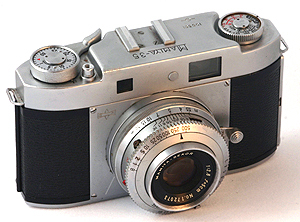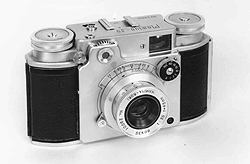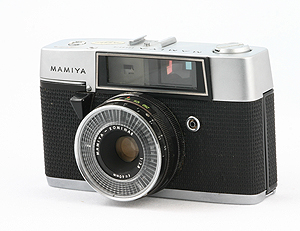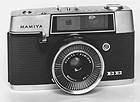 |
Manuals for Mamiya 35mm at
www.butkus.us
|
Mamiya 35mm Rangefinder Information Mamiya had already established a rich 35mm rangefinder heritage before they began producing 35mm SLR's. But good technical data is hard to find, and this information is a long way from complete. New information any Gentle Reader might have about these cameras will help make this site better and you are actively encouraged to submit it! Please consider joining the Collecting Mamiya 35mm Forum where you can share any of the much-needed information! |
|
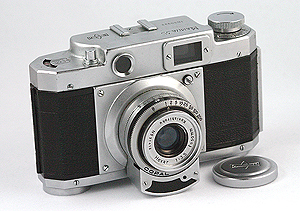 MAMIYA 35-I (c.1949) from the R.L. Herron Collection 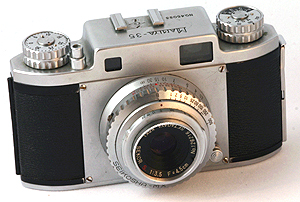 MAMIYA 35-II, (c.1955) from the R.L. Herron collection. |
Mamiya 35-I and 35-II Building on the success of the mid-size Mamiya-6 folder, which had quickly developed a reputation for reliability and unique design, Mamiya built an equally unique 35mm model. It was the first Japanese camera to automatically cock a leaf shutter as the film was wound. The Mamiya 35-I, (c.1949), with a fixed 5cm f/3.5 Hexar lens in a Copal B shutter, had speeds from 1 sec. to 1/200 and B. It featured a knob-wind film advance, and also adopted the unique backfocusing arrangement of the larger Mamiya-6, in which the lens did not move during focusing. Instead, the entire film plane itself moved within the camera, through the same ingenious mechanics that focused the Mamiya-6. There were problems, however, keeping the film flat in the 35mm format and the back-focusing 35mm was abandoned. The Mamiya 35-II, introduced in 1955, is immediately recognizable from the similar Mamiya 35-I that preceded it by the change in the distinctive round shape of the viewfinder window. The round viewfinder would not appear again on Mamiya 35mm rangefinder cameras. There were other noticeable differences, such as the squared-off top plate and the knurled film advance and rewind knobs. The 35-II was originally available with a f/3.5 lens (see picture at left), and a faster f/2.8 lens was sold in 1956. Remarkably sturdy cameras, both the Mamiya 35-I and 35-II can still occasionally be found today, although they are rare. One in serviceable or repairable mechanical condition is becoming extremely rare, with auction prices beginning to climb considerably. These are both extremely sought-after items for true Mamiya collectors. 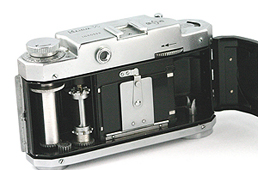 MAMIYA 35-I, showing the unique faceplate that held the film flat |
|
Mamiya Mammy The Mamiya Mammy, a low-priced camera with a strangely-shaped bakelite body, is worth mentioning as part of Mamiya's 35mm heritage. Introduced in 1953, this "camera for the masses," featured front lens focusing and produced 24x28mm exposures on paper-backed, unperforated 35mm film stock (828 film). The picture at right is my only good image of the camera. It apparently sold very well in Japan. However, I have been unable to find records to indicate how well it was received -- or if it was even marketed -- in the rest of the world. It is a very rare item today, and is seldom seen in auction. |
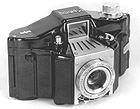 MAMIYA MAMMY (c.1953) |
|
|
Mamiya 35-III Its lens is a fixed 5cm f/2.8 Mamiya-Sekor in
a Seikosha-MXL shutter (speeds from 1 sec. - 1/500 including B).
Slightly more expensive, a version with an f/2.0 lens in the
same Seikosha shutter was also available. Both versions are rare
today. |
|
Mamiya Magazine
35 |
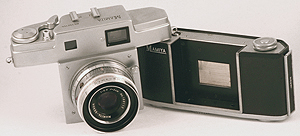 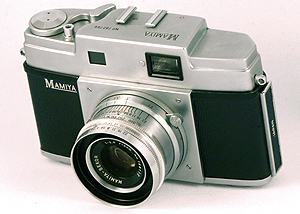 MAMIYA MAGAZINE 35 (c.1957) from the R.L. Herron collection. 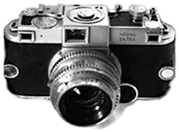 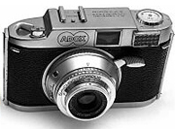 Kodak EKTRA (left; c.1939) and Adox 300 (right; c.1956) |
|
Mamiya Elca It was furnished with a fixed 5cm (50mm) Mamiya-Sekor f/2.8 lens in a Copal-Special-MXV shutter, with speeds from 1 - 1/500 and B. It is one of the rarer Mamiya rangefinders today. |
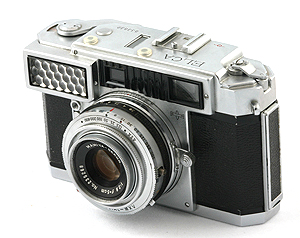 MAMIYA ELCA (c.1958) from the R.L. Herron collection. |
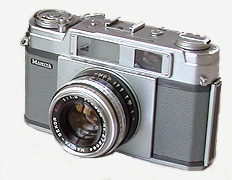 MAMIYA 35 CROWN (c.1958) from the R.L. Herron collection.
|
Mamiya 35
Crown The Mamiya 35 Crown (left), growing out of the Mamiya 35-III, related to the Mamiya 35-S and S2, and one of several sister cameras of the Mamiya Metra, was released in 1958. It featured a self-cocking lever and linked finder, but had no exposure meter. It was available with either a fixed f/1.9 or f/2.8 lens in a Seikosh-MXL shutter. Notable for its grey body covering, it was also marketed in some areas as the Mamiya Executive (some may have featured black covering). 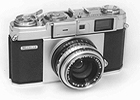 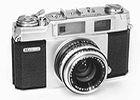 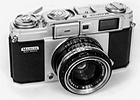 PICTURED ABOVE (left to right, beginning at top): MAMIYA METRA (c.1958) MAMIYA CROWN (c.1958) A version of the Metra without an exposure meter MAMIYA AUTO METRA (c.1959) 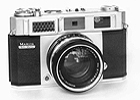 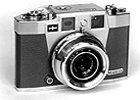 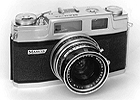 MAMIYA AUTO METRA-2 (c.1959) MAMIYA SKETCH (c.1959) Japan's first 24x24cm format with 35mm film. A format that never became popular in either the Japanese or export markets. It had first-class optics with a linked rangefinder, and was finished in grey leather. It is EXTREMELY RARE in auction today. MAMIYA 35-S2 (c.1959); Similar to the MAMIYA 35-S, which was released about the same time, the S2 was a coupled rangefinder with a 48mm Mamiya-Sekor f/2.8 helical focus lens, in a Copal-SV 1-500 shutter |
|
Mamiya Ruby  MAMIYA RUBY Meter Building on the Ruby line was the Mamiya M3, a less expensive cousin, introduced in May 1961. It featured a fully synchro flash contact, shutter speeds from 1 to 1/500, and came with a fixed 48mm Mamiya-Kominar f/2.0 lens. Yet another related camera, the Mamiya 4B, released in 1963, came with a selenium-cell meter, a fixed 40mm Mamiya-Kominar f/2.8 lens and a much more limited shutter (1/4 - 1/250). Similar Mamiya rangefinders were often rebranded as Rank Mamiya cameras when sold in the U.K. |
 MAMIYA RUBY (c.1960) from the R.L. Herron collection. 
 Above (left to right): MAMIYA - M3 (c.1961); and MAMIYA - 4B (c.1963) |
|
|
Mamiya EE Merit Both the EE Merit and Super Merit had a fixed
40mm f/2.8 Mamiya-Kominar lens, an automatic shot counter and
four shutter speed settings: 1/30, 1/60, 1/125 and 1/250. The
Super Merit is distinguishable by a slightly wider, black-framed
bezel around the front rangefinder window. Both versions were
also marketed by Honeywell as the Honeywell
Electric Eye 35. Yet another version was sold as the Mansfield
Eye-Tronic R. Mansfield was a division of Argus, Inc. 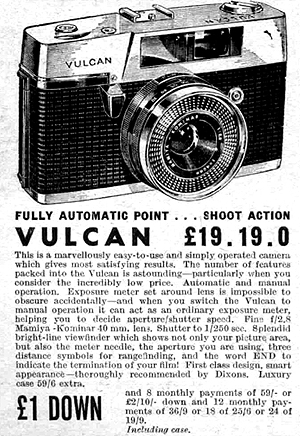 MAMIYA VULCAN, shown in an advertisement for UK retailer, Dixons, September 1963. Ad image courtesy Maurice Fisher. |
|
Mamiya Super
Deluxe Battery Note: You can find an acceptable zinc-air substitute for the 1.3v PX-675 mercury battery the Super Deluxe requires at PhotoBattery.com. A slightly more expensive adapter to convert 1.5v silver-oxide batteries to the proper 1.3v output is available. Have to check the web/Ebay. |
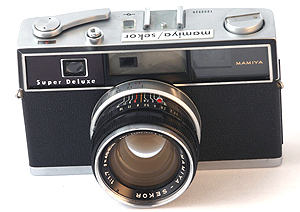 MAMIYA SUPER DELUXE 2.0 (c. 1964) from the R.L. Herron collection. 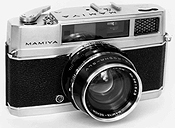 MAMIYA AUTO DELUXE (c. 1961) from the R.L. Herron collection. Another camera preceeding the Super Deluxe was the Mamiya Auto-Deluxe (above, c.1961). It had a coupled rangefinder with a match-needle selenium meter. Unlike most 35mm designs from Mamiya, the Auto-Deluxe had the meter cell at the left-hand side of the camera body. It was equipped with a 48mm Mamiya-Sekor f/1.7 1-500 lens and a Seikosha-SLV shutter. A variant of this camera was also sold branded as the Pro-Matic. |
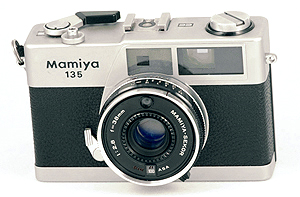 MAMIYA 135 EE (c.1977) from the R.L. Herron collection.
|
Mamiya
135  MAMIYA MYRAPID (above; c.1965) An automatic half-frame 35mm with a selenium cell surrounding the 32mm Tominon f/1.7 lens in an Auto Copal 1/30 - 1/800 shutter. It produced an 18x24mm image on Rapid-cassettes, which are no longer available. |
